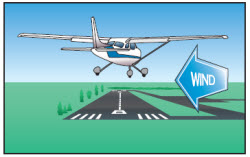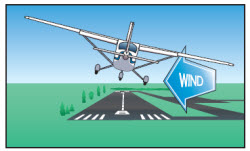Crosswind Takeoffs and Landings (Video)
Crosswinds can be a real problem – “On Landings Part I”
That is a actually a pretty good summary of how most pilots feel about crosswind takeoffs and landings.
Here are two usual methods taught in accomplishing a crosswind approach and landing:
The crab method

Crabbed Approach
The crab method is performed by establishing a heading toward the wind with the wings level so that the airplane’s ground track remains aligned with the centerline of the runway. This crab angle is maintained until just prior to touchdown, when the longitudinal axis of the airplane must be aligned with the runway to avoid sideward contact of the wheels with the runway.
Although I personally prefer using the crab procedure, one of the difficult things about this particular method is learning the timing and judgment needed during the flare. In essence what you are doing in the last few seconds is transitioning from a crab to a slip and getting that timing down can be a little tricky.
Sideslip

Sideslip Approach
The other crosswind landing method is the the wing-low or sideslip method. To use this method, start by aligning the airplane’s heading with the centerline of the runway. You’ll notice now that the aircraft starts drifting so in order to counteract this you’ll want to lower the upwind wing. With the aileron lowered the aircraft is going to want to turn right so we have to now apply just enough opposite rudder so that longitudinal axis of the airplane stays aligned with the centerline of the runway. In other words, the drift is controlled with aileron, and the heading with rudder. The airplane will now be sideslipping into the wind just enough that both the flightpath and the ground track are aligned with the runway. You’ll want to hold this all the way to touchdown. If the winds increase to the point that you begin running out of rudder to hold the slip, then it is time to look for a more suitable runway.
The FAA in FAA-H-8083Flight Training Handbook identifies these common errors during crosswind landings:
- Attempting to land in crosswinds that exceed the airplane’s maximum demonstrated crosswind component.
- Inadequate compensation for wind drift on the turn from base leg to final approach, resulting in undershooting or overshooting.
- Inadequate compensation for wind drift on final approach.
- Unstabilized approach.
- Failure to compensate for increased drag during sideslip resulting in excessive sink rate and/or too low an airspeed.
- Touchdown while drifting.
In this short classic flight training video, developed by the FAA, both crosswind takeoffs and landings are discussed. The first half of the video identifies and discusses common problem during crosswind takeoffs. The second half is devoted to the discussion and demonstration of crosswind approach and landings. This includes brief demonstrations of both the sideslip (or wing-low) and crab method of crosswind landings as discussed above.
You can also download “[download id=”8″]” which discusses other common problems during landings including crosswind discussion.


Gary Cassell on Jun 02, 2010
I once made a really nice cross wind landing. Right wing down, a little top rudder, touched down on the right main mount, lowered the left wing and eased the nose wheel to the ground.
Our Chief Pilot was observing. He made the comment, “Nice landing, only problem is the wind is from the opposite direction.”
Do you find anything odd about that statement?
Just how would you make a nice cross-wind landing if you had control corrections made in the opposite direction to the wind!
Ben on Jun 15, 2010
Love the video!
Just one thing though, at the end the narrator describes it as “keeping the centerline of the aircraft on the centerline of the runway.” While we all know what he means by that, I’ve always told my students to keep the longitudinal axis aligned with the projected centerline of the runway.